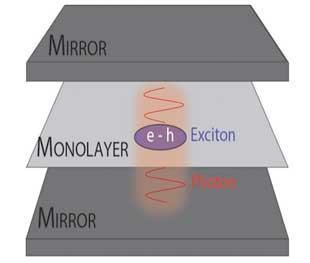| Dec 17, 2020 |
Polariton interactions: Light matters
(Nanowerk News) Why do two-dimensional exciton-polaritons interact?
|
|
The intriguing quasiparticle the exciton-polariton is part light (photon), and part matter (exciton).
|
|
Their excitonic (matter) part confers them the ability to interact with other particles —a property lacking to bare photons.
|
|
In theory, when confined to only two dimensions, very slow (ie, very cold) excitons should cease any interaction with one another. However in practice, this behaviour is not observed with exciton-polaritons.
|
|
In a new study (Physical Review Research, "Polariton interactions in microcavities with atomically thin semiconductor layers") by FLEET researchers at Monash University, the answer is found to lie in the ‘light-like’ characteristics of these quasiparticles.
|
|
This is important for future applications using polaritons in atomically-thin semiconductors, such as ultra-low energy electronics.
|
 |
| Exciton-polariton: hybrid quasiparticle between a photon (light) and an exciton (bound electron-hole pair). (Image: FLEET)
|
Enhanced interactions through strong light-matter coupling
|
|
‘We sought answers to a fundamental question about exciton-polaritons not asked previously,” explains lead author Dr Olivier Bleu.
|
|
“If polaritons live in two-dimensions, why is the disappearance of their interactions at slow velocities not happening in experiments, as predicted by quantum scattering theory?”
|
|
The team demonstrated that the strong-coupling between excitons and photons, together with the huge exciton-photon mass ratio, modifies the scattering behaviour expected for ‘bare’ two-dimensional excitons and implies that polariton interactions remain finite.
|
|
“More precisely, we showed that the regime where the interactions should vanish is not observable since it would require a sample much larger than the known universe!”, explains co-author Dr Jesper Levinsen.
|
|
The results show that polaritons interact more than excitons, which contrasts with the common assumption about these key quasiparticles.
|
|
“This work sheds new light on the interactions between hybrid light-matter quasiparticles, and will allow us to deepen our understanding of these systems,” says corresponding author A/Prof Meera Parish.
|
Quasiparticles that are both light and matter
|
|
Exciton-polaritons form when excitons (electron-hole pairs) are strongly-coupled with light (photons) trapped in an optical cavity.
|
|
This ‘split personality’ gives the exciton-polariton unique properties, taking some of the characteristics of light, and some of the characteristics of matter.
|
|
Their capacity to interact is at the heart of a variety of fascinating phenomena observable in experiments and still not completely understood: ranging from polariton Bose-Einstein condensation and superfluidity to quantum optical effects.
|

